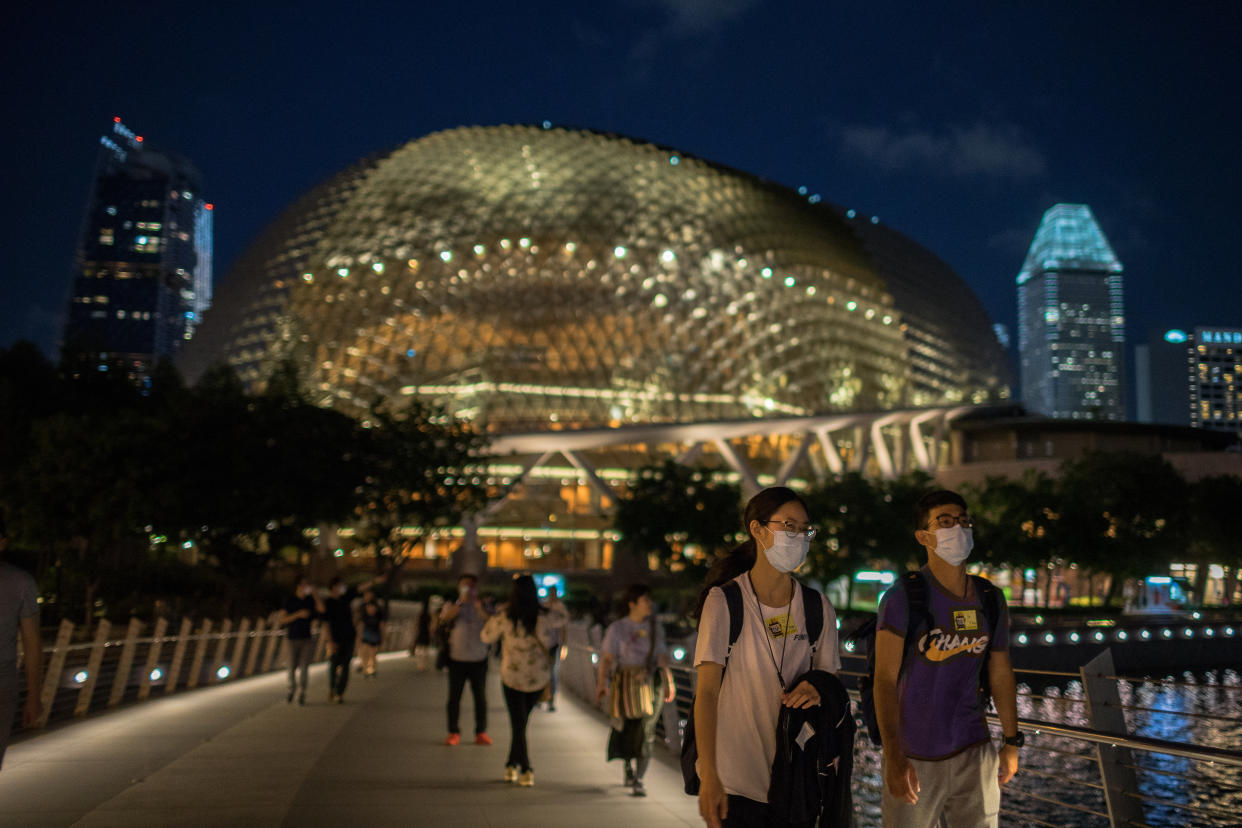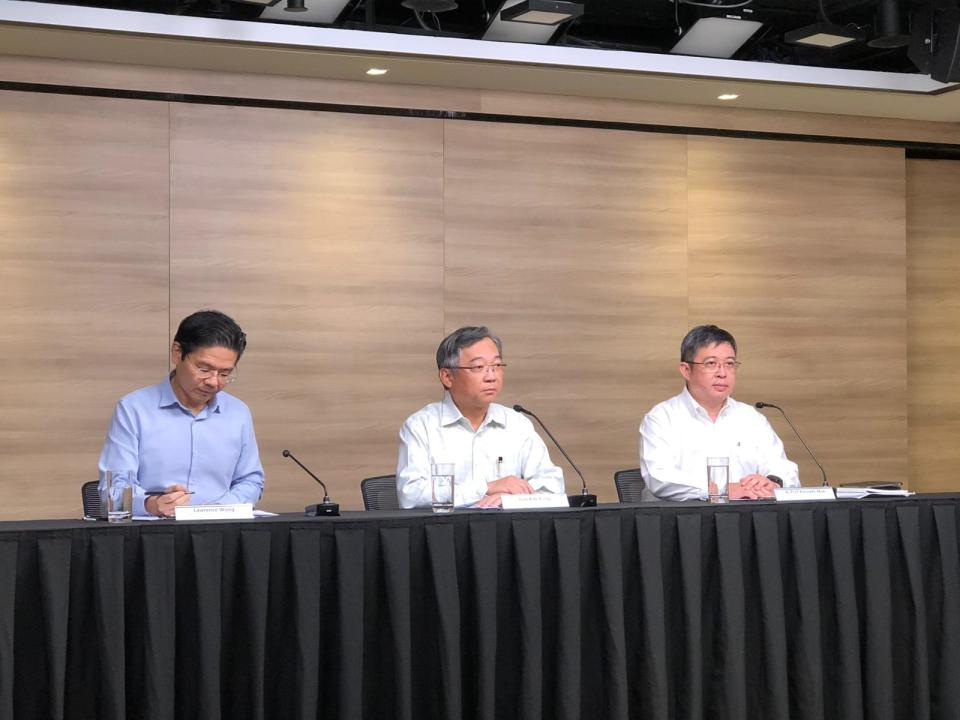COVID-19: Singapore confirms 9 new cases, 6 linked to Grace Assembly of God church; total at 67

By Nicholas Yong, Koh Wan Ting, and Wong Casandra
SINGAPORE — The Ministry of Health (MOH) on Friday (14 February) confirmed nine new cases of the novel coronavirus – the highest in a single day here to date – bringing the total number of cases here to 67.
All nine cases have no recent travel history to China, bringing the cases of local transmissions to 45, about two-thirds of the tally. Nine other cases have no established links to any previous cases or travel history to mainland China.
Associate Professor Kenneth Mak, MOH director of medical services, shared that six of the new cases are linked to the Grace Assembly of God church – one of at least five such identified clusters here – during a press conference led by a multi-ministry taskforce on the COVID-19 virus.
The other clusters are associated with health products shop Yong Thai Hang along Cavan Road, The Life Church and Missions Singapore in Paya Lebar, a business meeting at the Grand Hyatt hotel and a construction site at Seletar Aerospace Heights.
The new addition means that 13 of 67 confirmed cases are linked to Grace Assembly of God, making it the largest of the five clusters.
The remaining cases include an employee at a private hospital in Singapore and the other is a family member of a DBS employee confirmed to have the virus on Wednesday.
Prof Mak also said that two patients have fully recovered and have been discharged, bringing the total number of recovered cases to 17.
Six of the remaining 50 patients remain critically ill in the intensive care unit, while most are stable or improving.
When asked if there was a “super spreader” in the Grace Assembly of God church, Prof Mak said that there was not enough information to arrive at that conclusion.
Health Minister Gan Kim Yong, co-chair of the taskforce, stressed the importance of being prepared even while there is "currently no evidence" of widespread community transmission in Singapore.
Additional measures will be taken as “the situation evolves”, he added, noting that researchers have warned that there could be “many more” infections in communities around the world.
“Locally, we do expect the number of confirmed cases to increase over time. This is also partly due to the enhanced disease surveillance we have put in place," he added.
Taskforce co-chair and National Development Minister Lawrence Wong said, "A few days ago, Prime Minister Lee spoke about the scenario where the virus may become more widespread and we have to change our approach."
He added, "We are not there yet."
Gan stressed that Singapore authorities have no plans to upgrade the Dorscon alert level from orange to red.
“Please help me stop the rumour. It’s already difficult, challenging enough to stop the spread of the virus...I want to say categorically that we have no plans to go to Dorscon red,” he said.
Case 60-63, 66, 67: Grace Assembly of God patients, including PUB employee
One of the six cases linked to the church is a 51-year-old Singaporean woman who works at its Tanglin branch. She reported developing symptoms on 8 February and sought treatment at a general practitioner clinic on the same day.
She went to NCID on Wednesday and was immediately isolated. She later tested positive for the virus on Thursday afternoon and is currently warded in an isolation room at the NCID.
Prior to her hospital admission, she had mostly stayed at her home at Ang Mo Kio Avenue 3 and went to work.
Another case is a 57-year-old male Singaporean man who works at Legacy Office Supplies at 56 Senang Crescent. He reported developing symptoms on 6 February, and sought treatment at a general practitioner clinic on the same day and again on 8 February.
He went to Ng Teng Fong General Hospital on 9 February and Pioneer polyclinic on Tuesday and Wednesday. The man later tested positive for the virus on Thursday afternoon and is currently warded in an isolation room at the National University Hospital.
Prior to his hospital admission, he reported that he had mostly stayed at home at Jurong West Street 64, except to go to work for a day.
The third case is a 44-year-old Singaporean woman, who reported developing symptoms on 9 February, and sought treatment at a general practitioner clinic the next day. She went to Singapore General Hospital (SGH) on Wednesday and was immediately isolated.
She later tested positive for the virus on Thursday afternoon and is currently warded in an isolation room at the SGH.
Prior to her hospital admission, she reported that he had mostly stayed at home at Tanjong Pagar Road, except to seek medical treatment.
The fourth case linked to the church cluster is a 54-year-old woman who works at the Public Utilities Board (PUB).
In response to media queries, a spokesperson for the statutory board said that she is an administrative staff who works in its Environment Building at 40 Scotts Road, and is not involved in its plant or field operations.
All 70 employees on the affected level in the building were asked to leave and telecommute for the rest of Friday, to facilitate the cleaning and disinfection of the office, said the spokesperson.
“There was no evacuation of the building” and staff members are expected to return to work on Monday, the spokesperson added.
The agency also said that it has commenced the rehearsal of splitting its senior management team this week.
“We periodically exercise business continuity plans, of which operating split teams is one component. We regret that earlier media reporting has conflated this with the confirmed infection,” said the spokesperson.
Additional measures include stepping up cleaning of common areas, making hand sanitisers readily available as well as providing every employee with a thermometer and reporting their body temperature twice daily.
The remaining two cases, both Singaporeans, tested positive for the virus on Friday morning. They are a 28-year-old man and a 56-year-old woman who is a family member of the 57-year-old man.
Case 59: Private hospital employee
One of the new cases is a 61-year-old Singaporean man who works at a private unnamed hospital in Singapore and has not been at work since he developed symptoms on 7 February.
He sought treatment at Farrer Park Hospital’s emergency care clinic three days after reporting symptoms.
He went to the emergency department at Mount Elizabeth Hospital on Wednesday.
The man was conveyed by ambulance to the NCID on Thursday, where he is currently warded in an insolation room. He tested positive on the afternoon of the same day.
Prior to his hospital admission, he had mostly stayed home at Wilkinson Road, except to seek medical treatment, and had no known interactions with past cases.

Case 64, 65: Unknown link; family member of DBS employee
The last two new cases announced on Friday is a 50-year-old Singaporean man and a 61-year-old female Singaporean, who is the second family member linked to a DBS employee confirmed with the virus.
As of Friday noon, 764 of the suspect cases have tested negative for the virus, while test results for the remaining 91 are pending.
As of Thursday noon, the MOH has identified 1368 close contacts. Of the 1247 contacts who are still in Singapore, 1234 have been contacted and are being quarantined or isolated. Efforts are ongoing to contact the remaining 13 close contacts, said the ministry.
The MOH also reiterated its advice for Singaporeans to defer all travel to Hubei province, home to Wuhan where the virus originated, and all non-essential travel to mainland China.
COVID-19’s death toll surpasses SARS epidemic
The novel strain belongs to the same family of coronaviruses as Severe Acute Respiratory Syndrome (SARS), which killed nearly 800 people globally during a 2002-2003 outbreak and also started in China.
It likely originated from Wuhan’s Huanan Seafood Market, where live animals or products – such as foxes, wolf puppies, giant salamanders, snakes, porcupines, and camel meat – are sold.
Declared a global emergency by the World Health Organisation (WHO), COVID-19 has spread to 27 territories beyond mainland China. The WHO also said that cases being transmitted by people who have never travelled to China could be the "tip of the iceberg".
By territory, Singapore has the second-highest number of confirmed COVID-19 cases after mainland China.
The global tally includes cruise ship Diamond Princess, moored off Japan, which has 218 cases. Five Singaporeans on board the ship have reported that they are physically well, said a Ministry of Foreign Affairs spokesperson on Wednesday, in response to Yahoo News Singapore’s queries.
Almost 1,400 people have died of the virus in China, which has sickened over 64,000 people. The last two days saw a steep rise in the number of cases after a change in diagnostic methods in the country.
The National Health Commission disclosed a statistical error, saying it removed 108 deaths in Hubei that had been double-counted, but the nationwide toll still rose to 1,380 on Friday.
Three territories, Japan, Hong Kong, and the Philippines, have each reported the death of a patient infected with the virus.
Patients suffering from the new strain may exhibit fever and symptoms of lower respiratory illness – such as coughing or difficulty in breathing – as well as pneumonia-like symptoms like a runny nose, sore throat, and headache.
However, some who have died from it have not displayed symptoms of fever, according to details released by China’s National Health Commission, potentially complicating global efforts to check for infected travellers as they arrive at airports and other travel hubs.
Stay in the know on-the-go: Join Yahoo Singapore's Telegram channel at http://t.me/YahooSingapore
Related stories:
Coronavirus: How it's spreading in Singapore and the world
COVID-19: Catholic Church in Singapore suspends all Masses
COVID-19: Singapore announced eight new cases linked to previous patients, total at 58
COVID-19: Singapore economy to 'take a hit', recession possible due to outbreak - PM Lee
COVID-19: Healthcare workers get help in seeking refunds for cancelled holiday plans
COVID-19: $77m package for taxi, private-hire car drivers amid falling ridership


